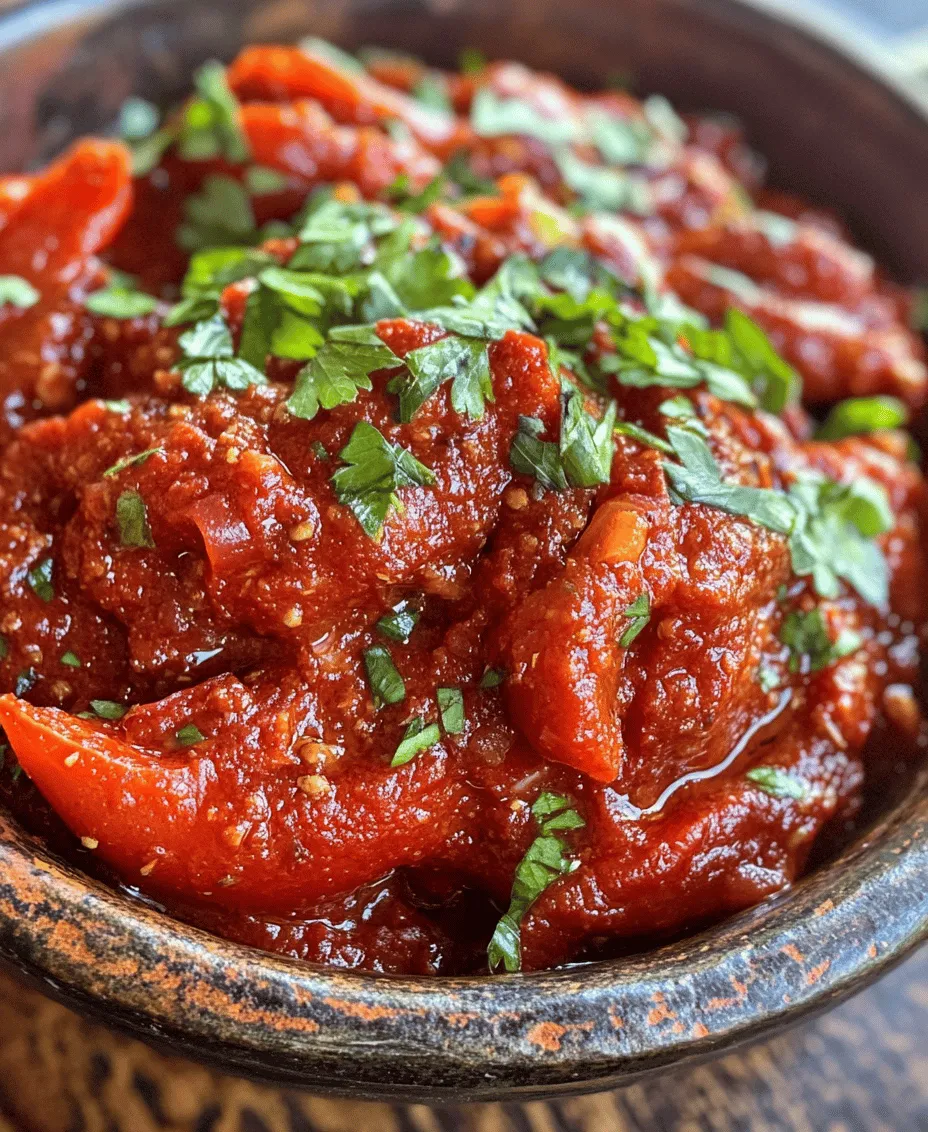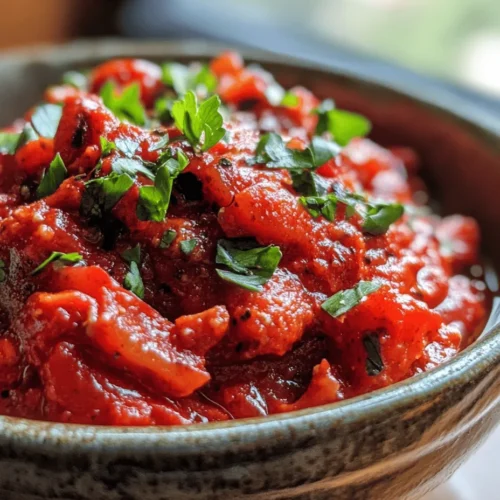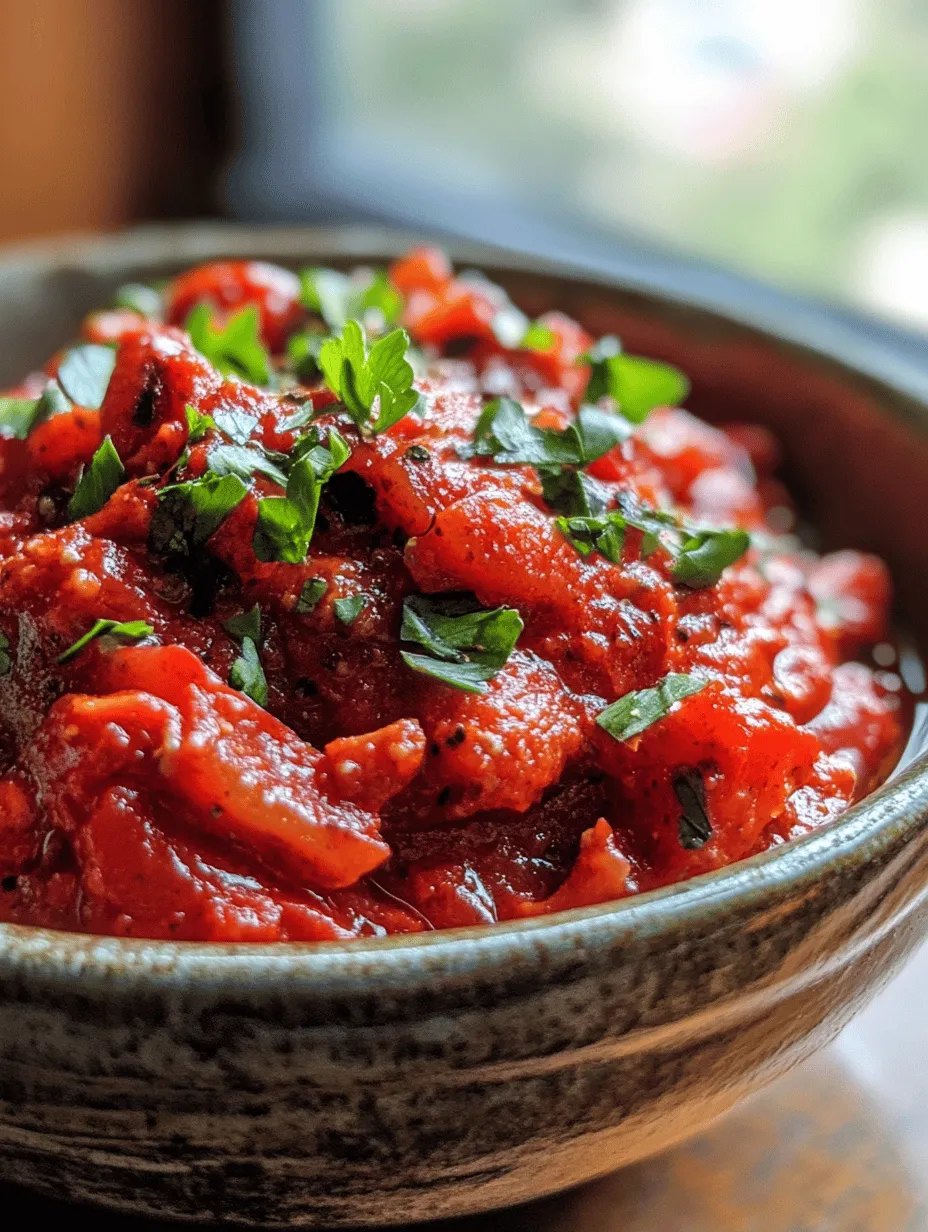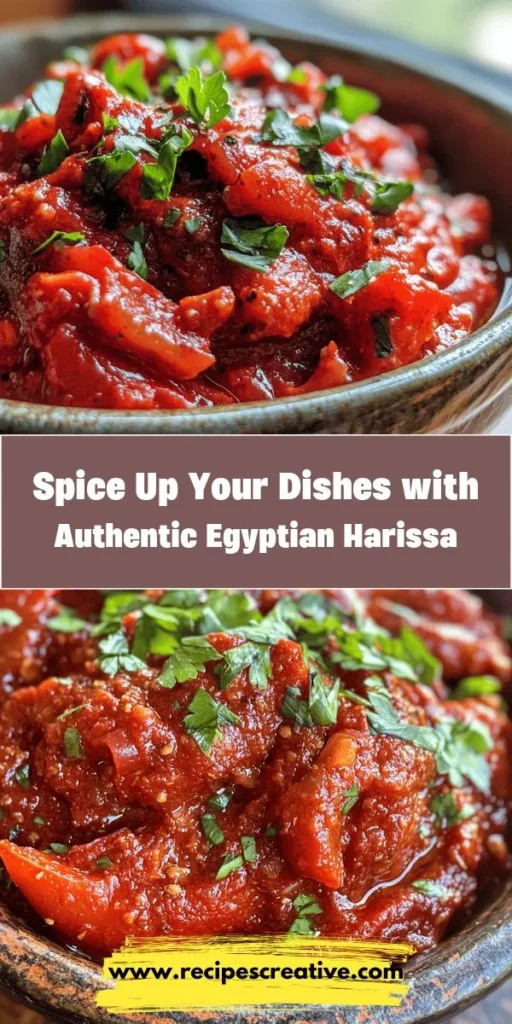Discover the vibrant world of Egyptian cuisine through the lens of harissa, a beloved spicy condiment that adds depth and flavor to a variety of dishes. This traditional North African sauce is known for its bold flavors, combining roasted peppers, spices, and olive oil to create a versatile addition to any meal. In this article, we will explore the origins of harissa, its cultural significance, and provide a detailed recipe for making authentic Egyptian harissa at home. Whether you’re a seasoned chef or a novice cook, this guide will equip you with everything you need to know to create this delicious condiment.
Understanding Harissa: The Essence of Flavor
The Historical Background of Harissa
Harissa has its roots in the culinary traditions of North Africa, particularly in Tunisia, Algeria, and Morocco. It is believed that the sauce was developed by Berber tribes, who used local ingredients to create a flavorful paste that could enhance their meals. Over time, harissa has evolved and adapted to various regional tastes, solidifying its place in the hearts of food lovers across North Africa and the Middle East.
In Egypt, harissa is not just a condiment; it is an integral part of the culinary landscape. The Egyptians have embraced this spicy sauce, incorporating it into a wide range of dishes, from grilled meats to stews and even dips. Each region of Egypt has its unique twist on the classic recipe, showcasing local ingredients and spices, which reflects the country’s rich history of trade and cultural exchange.
Exploring the Regional Variations of Harissa
While the fundamental components of harissa remain consistent—roasted peppers, spices, and olive oil—regional variations highlight the diversity of flavors that can be achieved. For instance, Tunisian harissa is known for its fiery heat, often incorporating a variety of dried chilies, while Moroccan versions may include additional spices such as cinnamon or saffron, giving the sauce a sweet and aromatic profile.
In Egypt, harissa is often milder than its Tunisian counterpart, focusing on the balance of flavors rather than overwhelming heat. The use of roasted red bell peppers and a careful blend of spices allows for a smoother, creamier texture that complements a variety of dishes without overpowering them. This adaptability makes Egyptian harissa a favorite among home cooks and professional chefs alike.
Cultural Significance in Egyptian Cuisine
The significance of harissa in Egyptian cuisine cannot be overstated. It is often served alongside grilled meats, fish, and vegetables, acting as both a condiment and a marinade. Beyond its culinary uses, harissa holds cultural importance, symbolizing hospitality and generosity in Egyptian households. When guests are welcomed into an Egyptian home, it is customary to serve them a spread that includes harissa, enhancing the overall meal experience.
Moreover, harissa is also used in traditional celebrations and gatherings, showcasing the deep-rooted connection between food and culture in Egypt. As the country continues to embrace modern culinary trends, harissa remains a staple, bridging the gap between traditional practices and contemporary cooking.
Ingredient Breakdown: What Makes Egyptian Harissa Unique
To create authentic Egyptian harissa, it’s essential to understand the key ingredients that contribute to its distinctive flavor profile. Here is an overview of the primary components:
Overview of Key Ingredients
1. Roasted Red Bell Peppers: The star ingredient of Egyptian harissa, roasted red bell peppers add sweetness and depth to the sauce. Their vibrant color not only enhances the visual appeal of the condiment but also contributes to its rich flavor.
2. Dried Red Chilies: For those who enjoy a bit of heat, dried red chilies are a critical addition. They can vary in heat levels, allowing you to customize the spiciness of your harissa according to your preference.
3. Aromatics: Garlic and fresh herbs play a pivotal role in elevating the flavor of harissa. Garlic adds a pungent kick, while herbs like cilantro or parsley bring freshness and brightness to the sauce.
4. Spices: The inclusion of spices such as cumin, coriander, and paprika enhances the complexity of the flavor profile. Each spice contributes its unique notes, creating a well-rounded and aromatic condiment.
5. Olive Oil: The role of olive oil in harissa is twofold. It not only provides a creamy texture but also helps to meld the flavors of the other ingredients together, resulting in a harmonious sauce.
The Role of Roasted Red Bell Peppers
Roasted red bell peppers are essential for achieving the signature sweetness and depth of flavor in Egyptian harissa. The roasting process caramelizes the natural sugars in the peppers, resulting in a rich and smoky taste that forms the base of the sauce. To roast red bell peppers, simply place them under a broiler or on a grill until the skin is charred and blistered. Once roasted, they can be easily peeled and blended into a smooth paste. This step is crucial, as it not only enhances the flavor but also improves the texture of the final product.
The Impact of Dried Red Chilies on Heat Levels
Dried red chilies are the key to controlling the heat level of your harissa. Depending on your heat tolerance, you can choose different varieties of chilies. For a milder sauce, opt for sweeter varieties like ancho chilies, while for a spicier kick, consider using bird’s eye chilies or cayenne. Soaking the dried chilies in warm water for about 30 minutes before blending can help soften them, making it easier to achieve a smooth consistency in the sauce. This soaking process also allows the flavors to bloom, ensuring a more robust final product.
The Importance of Aromatics: Garlic and Fresh Herbs
Aromatics like garlic and fresh herbs are critical for adding depth and brightness to Egyptian harissa. Garlic, in particular, imparts a sharp, savory flavor that balances the sweetness of the roasted peppers. Fresh herbs, such as cilantro or parsley, lend a refreshing quality that can help lighten the overall richness of the sauce. When preparing your harissa, feel free to experiment with different herb combinations to find the perfect balance that suits your palate.
Spices that Elevate the Flavor: Cumin, Coriander, and Paprika
The spices used in Egyptian harissa play a fundamental role in defining its character. Cumin adds a warm, earthy note, while coriander contributes a citrusy brightness. Paprika, whether sweet or smoked, can enhance the color and add a subtle smokiness to the sauce. The right blend of these spices will create a complex flavor profile that beautifully complements the sweetness of the peppers and the heat of the chilies.
The Role of Olive Oil in Creating Creaminess
Olive oil is not just a mere ingredient; it is a vital component that brings the harissa together. The oil adds a velvety texture, making it easier to spread or mix into various dishes. Additionally, the oil helps to preserve the harissa, allowing it to be stored for longer periods without losing its flavor. When blending the harissa, gradually drizzle in the olive oil until you achieve the desired consistency, ensuring a well-emulsified sauce.
Step-by-Step Guide to Making Egyptian Harissa
Creating authentic Egyptian harissa at home is a straightforward process that requires minimal ingredients but delivers maximum flavor. By following this step-by-step guide, you’ll be well on your way to preparing a delicious sauce that can elevate any meal.
Preparing the Red Bell Peppers: Roasting Techniques
To start, you’ll need to roast your red bell peppers. Preheat your oven to 450°F (230°C) or set your grill to medium-high heat. Place the whole red bell peppers directly on the oven rack or grill grates. Roast them for about 20-30 minutes, turning occasionally, until the skins are charred and blistered on all sides. This process enhances the flavor and makes peeling the peppers much easier.
Once roasted, transfer the peppers to a bowl and cover it with plastic wrap. This creates steam, which helps loosen the skins. Allow the peppers to sit for about 10-15 minutes. Afterward, peel the skins off, remove the stems and seeds, and chop the peppers into smaller pieces for blending.
Effective Methods for Peeling and Seeding Peppers
Peeling and seeding roasted peppers can seem daunting, but it’s quite simple. After allowing the roasted peppers to steam, use your hands or a paper towel to gently rub off the charred skin. The skins should come off easily. Cut the peppers open, remove the seeds, and discard them along with the stems. If you prefer a smoother texture in your harissa, ensure that all the seeds are removed, as they can add a bitter taste.
Soaking Dried Chilies: Achieving the Right Heat
While your roasted peppers are cooling, it’s time to prepare the dried chilies. Select your preferred variety based on the heat level you desire. Remove the stems and seeds from the dried chilies, then place them in a bowl and cover them with warm water. Allow the chilies to soak for about 30 minutes, which will soften them and make them easier to blend. This step is crucial for achieving a smooth and cohesive harissa.
Once the chilies have soaked, drain them and set them aside. You can now proceed to blend your ingredients together to create a vibrant and flavorful Egyptian harissa that is sure to impress.
By understanding the rich history and unique ingredients that contribute to Egyptian harissa, as well as following the step-by-step preparation methods, you are well on your way to creating this delightful condiment in your own kitchen. Enjoy the journey into the heart of Egyptian cuisine as you embark on this flavorful adventure.

Blending the Ingredients: Achieving the Perfect Consistency
Once you have gathered all your ingredients, the next step is to blend them into a smooth paste. Begin by placing the roasted peppers, garlic, and spices into a food processor or blender. It’s crucial to ensure that the peppers are properly peeled and deseeded to avoid any bitterness. For added depth of flavor, include the toasted coriander seeds, cumin seeds, and caraway seeds into the mix. These spices will enhance the aroma and give the harissa its distinctive flavor profile.
As you blend, gradually incorporate a small amount of water to help achieve the desired consistency. The goal is to create a smooth, thick paste that is neither too watery nor too dry. Scrape down the sides of the processor as needed to ensure that all ingredients are well combined. The blending process typically takes about 2-3 minutes, but you may need to adjust the timing based on your specific equipment. The final texture should be creamy, allowing the harissa to spread easily or be used as a dipping sauce.
Incorporating Olive Oil: Tips for a Creamy Texture
To achieve that signature rich and creamy texture that harissa is known for, it’s time to incorporate the olive oil. Start by drizzling a moderate amount of extra virgin olive oil into the blending mixture while the processor is running. This will emulsify the oil with the other ingredients, resulting in a luscious, silky sauce. The quantity of olive oil you use can vary based on your preference; typically, ¼ to ½ cup is sufficient for a batch of harissa.
Keep blending until the oil is fully incorporated, and the mixture is homogenous. The olive oil not only adds creaminess but also enhances the flavor, making your homemade harissa more aromatic and vibrant. If you prefer a more robust flavor, consider substituting some olive oil with flavored oils, such as garlic-infused olive oil, but be cautious not to overpower the other ingredients.
Final Touches: Adjusting Seasoning and Presentation
After blending, it’s essential to taste your harissa and adjust the seasoning as necessary. You may find that it needs more salt, acidity, or heat depending on your palate. If you prefer a spicier kick, consider adding a pinch of cayenne pepper or a few extra chili flakes. For added brightness, a splash of lemon juice can also elevate the flavor profile.
Once you are satisfied with the taste, transfer the harissa to a clean glass jar or container. For an appealing presentation, drizzle a little extra olive oil over the top before sealing the jar. This not only enhances the visual appeal but also helps preserve the harissa by creating a barrier against air exposure.
Serving Suggestions: How to Enjoy Harissa
Pairing Harissa with Traditional Egyptian Dishes
Harissa is a versatile condiment that can be paired with a variety of traditional Egyptian dishes. It complements grilled meats, such as kebabs or shawarma, perfectly. Simply serve a dollop of harissa alongside your main dish for a burst of flavor. It can also be mixed into rice or grain dishes for added spice.
Another popular way to enjoy harissa is with roasted vegetables. Toss your favorite seasonal vegetables with harissa before roasting them in the oven for a delicious side dish. The heat from the harissa will caramelize beautifully during cooking, enhancing the overall flavor.
Incorporating Harissa into Modern Recipes
While harissa has deep-rooted traditions, it can also be a fantastic addition to modern cuisine. Use it as a marinade for chicken or fish, infusing your proteins with a zesty kick before grilling or baking. You can also mix harissa into dressings for salads, giving a simple vinaigrette a new life.
For a unique twist, try incorporating harissa into soups or stews. A spoonful can elevate the broth, providing depth and warmth. It works particularly well in lentil soups or chickpea stews, adding a complex flavor that beautifully complements the earthiness of the legumes.
Using Harissa in Mezze Platters and Appetizers
Harissa is also an excellent addition to mezze platters, which are perfect for entertaining. Serve it alongside hummus, babaganoush, and olives for a delightful spread. You can also create harissa-spiced dips by mixing it with yogurt or sour cream, offering a cooling contrast to its heat.
For appetizers, consider spreading harissa on flatbreads or pita before topping them with grilled vegetables or feta cheese. This creates a flavorful base for a variety of toppings, making it a crowd-pleaser at any gathering.
Storage and Shelf Life of Homemade Harissa
Best Practices for Storing Harissa
Proper storage is key to maintaining the freshness and flavor of your homemade harissa. After preparing your harissa, transfer it to an airtight container. Glass jars with tight-sealing lids are ideal, as they prevent air from degrading the sauce. Always ensure that the harissa is completely cooled before sealing the container to avoid condensation buildup inside.
If you prefer to store your harissa for an extended period, consider adding a layer of olive oil on top of the paste before sealing. This layer helps to preserve the harissa by preventing air exposure and oxidation.
Understanding the Shelf Life: Refrigeration and Freezing Tips
Homemade harissa can be stored in the refrigerator for up to three weeks. However, always check for any signs of spoilage before use. If you want to keep your harissa for longer, freezing is a great option. Portion the harissa into ice cube trays, freeze until solid, and then transfer the cubes to a freezer-safe bag. This allows you to defrost small amounts as needed without thawing the entire batch.
When stored in the freezer, harissa can last up to 6 months. Just remember to label your containers with the date, as this will help you keep track of how long it has been stored.
Using Leftover Harissa in Other Dishes
If you find yourself with leftover harissa, don’t let it go to waste! There are countless ways to incorporate it into your meals. Use it as a spread on sandwiches or wraps for an exciting flavor boost. You can also mix it into pasta sauces for an extra kick or use it to spice up grain bowls.
Try adding a spoonful to your morning eggs, whether scrambled, poached, or in an omelet, for a deliciously spicy breakfast option. The versatility of harissa means that you can get creative and enjoy it in numerous dishes.
Nutritional Benefits of Harissa
Exploring the Health Benefits of Key Ingredients
Beyond its bold flavor, harissa also offers several health benefits thanks to its key ingredients. The primary component, chili peppers, are rich in vitamins A and C and contain capsaicin, which has anti-inflammatory properties and may boost metabolism. Garlic, another essential ingredient, is known for its immune-boosting capabilities and cardiovascular benefits.
The spices used in harissa, such as cumin and coriander, also contribute to its health benefits. Cumin is known for its digestive properties, while coriander has been linked to lowering blood sugar levels. Together, these ingredients create a flavorful sauce that not only enhances your meals but also supports your health.
Understanding the Nutritional Profile of Harissa
A typical serving of harissa (about one tablespoon) is low in calories, making it a guilt-free addition to meals. It is primarily composed of healthy fats from the olive oil, providing a source of monounsaturated fats that are beneficial for heart health. The exact nutritional profile can vary based on the specific ingredients and quantities used, but generally, harissa is a nutritious condiment.
Incorporating Harissa into a Balanced Diet
Incorporating harissa into your diet can be a delicious way to enhance meals without adding excessive calories or unhealthy ingredients. Pair it with wholesome grains, lean proteins, and plenty of vegetables for a balanced plate. By using harissa as a flavor enhancer rather than a main ingredient, you can enjoy its benefits while maintaining a healthy diet.
Conclusion: Embrace the Flavors of Egyptian Harissa
In summary, Egyptian harissa is more than just a condiment; it’s a celebration of flavors and a testament to the rich culinary heritage of Egypt. By following this detailed recipe and understanding the cultural context and nutritional benefits, you will not only enhance your cooking repertoire but also gain a deeper appreciation for this flavorful sauce. Whether enjoyed on its own or as part of a larger meal, harissa is sure to spice up your culinary adventures.
Embrace the versatility of harissa by exploring its many applications in traditional and modern dishes alike. With its vibrant taste and healthful properties, harissa can easily become a beloved staple in your kitchen. So go ahead, whip up a batch of homemade Egyptian harissa, and let the flavors transport you to the heart of Egypt with every delicious bite.



